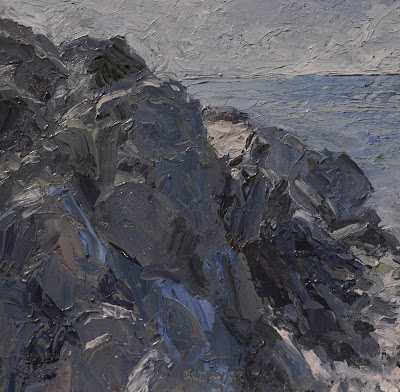Salt Air, Near Cutler, Maine
oil on mounted canvas
32" x 32"
"The way I feel about things is so much better than the way I've been able to paint them. The image I had in my head before I started is not quite - never quite - completely conveyed in paint."
Andrew Wyeth
"What is it that you express in your eyes? It seems to me more than all the print
I have read in my life."
Walt Whitman
Wyeth is right, of course: one cannot make paint do magic or capture light. All one is left with is to find and express the effect of light and shadow, the color of the atmosphere at a particular time of day in a particular place. One cannot get bogged down with what one painter called the "tragic inevitability", that the whole enterprise might have been better with a completely different approach. Instead one must cling to the initial poetic spark as long as possible and mine that spark for color scheme and design choices. And as one eases into the painting, allow the painting process to gain an equal voice as measured against the origin. Allow the painting to tell what it needs, what should be discarded. Then a different kind of magic emerges - the effect of the poetic beginning filtered through the artist's sensibilities and struggles. While the work may not completely convey the original vision it now carries a piece of the artist's spirit (especially true of the power of Wyeth's work).
What could be better than this outcome for any of us? Enjoy!













